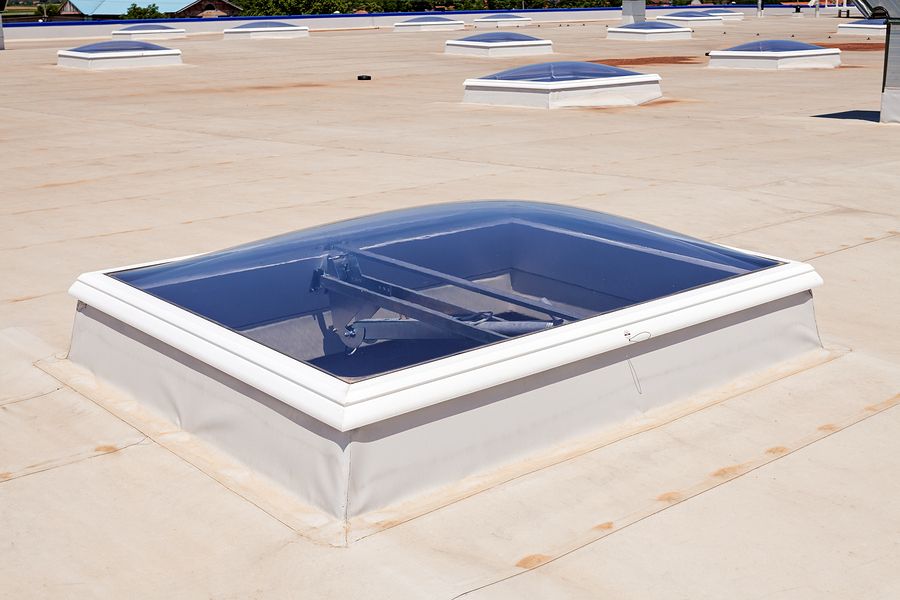Are Burglar Bars Compliant Skylight Fall Protection?

It’s easy to read the title above and think that you’re going to find a yes or no answer to the question. But the fact that there is a whole article indicates what you were probably afraid of.
The answer isn’t that simple.
The confusion comes from a few places. First, OSHA doesn’t have any language that specifically addresses “burglar bars”. So, in order to determine whether or not they would be compliant, we need to look elsewhere. Since OSHA considers skylights to be a “hole” in a walking/working surface, those are the regulations we need to turn to.
Second, OSHA’s current language regarding covers for skylights (or covers for any hole, really) is fairly vague.
So, burglar bars are not specifically mentioned, and the closest simile (covers) has code that leaves a bit to be desired. Let’s look at what OSHA says and see how best to find out if burglar bars are a compliant solution.
What Does Federal OSHA Say about Burglar Bars as Skylight Protection?
Currently, not much.
In 29 CFR 1928(b)(3), OSHA lists the allowable protections for holes in walking/working surfaces. In short, the list includes covers, guardrail systems, travel restraint systems, and/or personal fall arrest systems. If burglar bars were to fall into any of these categories, they would have to be “covers”. Therefore, we need to look to 29 CFR 1910.29(e) for further guidance.
29 CFR 1910.29(e)
Covers. The employer must ensure each cover for a hole in a walking/working surface:
29 CFR 1910.29(e)(1)
Is capable of supporting without failure, at least twice the maximum intended load that may be imposed on the cover at any one time; and
29 CFR 1910.29(e)(2)
Is secured to prevent accidental displacement.
If you feel this is still a bit vague, you’re not wrong. However, that doesn’t mean being vague wasn’t OSHA’s intent. Remember, OSHA’s job isn’t to tell you how to perform your work. It tells you what guidelines you need to work within to provide the minimum safe work environment. At least now, you have a framework.
Technically, if your burglar bars meet the above standards, you can argue that they are a compliant option for skylight fall protection. This will depend on how the OSHA inspector chooses to interpret the code for skylight safety.
CalOSHA addresses burglar bars with more clarity. Let's take a look at how they can be addressed more directly.
What does CalOSHA say about burglar bars?
In CalOSHA’s regulations, §3212. Floor Openings, Floor Holes, Skylights and Roofs. states:
(e)(2) Skylight screens installed below the skylight. Existing screens (i.e. burglar bars) shall meet the following requirements if they will be relied upon for fall protection:
- Screens installed at the same level or higher than the walking/working surface shall meet the strength requirements of subsection (b).
- Screens installed within 2 feet of the walking/working surface shall meet the strength requirements of subsection (b) with increased strength based on the fall distance below the walking/working surface as determined by a qualified person. In no case shall the strength of the screen below the skylight be less than the strength requirements of subsection (b). A screen more than 2 feet below the walking/working surface shall not serve as fall protection.
- A screen shall not be used for fall protection in accordance with subsection (e)(2)(A) or (e)(2)(B) if the broken skylight glazing will pose an impalement hazard to a worker who has fallen through the skylight and is lying on top of the screen. Skylights containing tempered, laminated, or plastic glazing, or similar materials shall not be considered to impose an impalement hazard.
- D. The screen construction shall be of grillwork, with openings less than 12 inches in the least horizontal dimension.
Here, we have much more specific information than OSHA provided. It directly addresses burglar bars, gives strength requirements, instructs in the use of a Qualified Person, addresses when broken glass should be taken into consideration, and what the dimensions of the grillwork should be. Frankly, CalOSHA leaves very little to interpretation.
What if you don’t live in California?
Simply put, you don’t need to live in California to follow their standards as long as they are equal to or more stringent than the regulations you are subject to. In this particular case, you could use CalOSHA’s requirements as your bare-minimum standard for burglar bars (since they are specifically addressed). Then ensure that by meeting CalOSHA’s requirements, you’ve also met OSHA’s (or, again, whichever regulations you are subject to).
Remember, OSHA’s regulations are a bare minimum. There is absolutely nothing that says you can’t go above and beyond (in fact, you are often encouraged to).
Also, heed this one warning: Beware materials that are stamped “OSHA Approved.” OSHA doesn’t approve anything, and for good reason. In this situation, how could OSHA, or any manufacturer, know what 2x your maximum intended load is (one of the requirements in part b of the CalOSHA standard referenced above)? They can’t. The burden of compliance is always on the employer, so make sure your qualified person is the one determining that your burglar bars are sufficient.
Are burglar bars compliant skylight fall protection?
They can be. If you’re in California, then they are as long as you follow the code we mention above. If you’re not, then it will depend on the OSHA inspector and how they choose to define “cover”.
If you choose to use burglar bars, then make sure you follow the rules listed in CalOSHA at the minimum. Remember, the more important question to ask is “Are burglar bars the safest option to use?”.
Debris (like a broken skylight) can fall through the bars on top of people or machinery, causing damage that makes it not worth using a burglar bar.
It’s important to remember that OSHA has a general duty clause to ensure that you provide a safe and healthful work environment. The responsibility is on you to ensure that burglar bars can provide such a workplace for your employees.
If you are still not sure what to do, then contact an expert that will help you work through your safety plan. The bottom line is to keep people safe and we’re here to help you do that.



